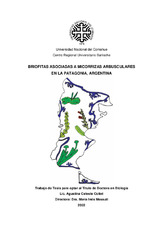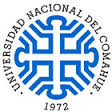- RDI Home
- →
- Centro Regional Universitario Bariloche
- →
- Tesis de Postgrado
- →
- View Item
JavaScript is disabled for your browser. Some features of this site may not work without it.
| dc.contributor.advisor | Messuti, María Inés | es_ES |
| dc.creator | Cottet, Agustina Celeste | |
| dc.date | 2022 | |
| dc.date.accessioned | 2023-05-05T14:45:07Z | |
| dc.date.available | 2023-05-05T14:45:07Z | |
| dc.identifier.uri | http://rdi.uncoma.edu.ar/handle/uncomaid/17136 | |
| dc.description.abstract | Las briofitas se incluyen dentro de tres Phyla: Anthocerotophyta (Bryophyta ( y Marchantiophyta ( Estas plantas juegan roles importantes en los ecosistemas ya que, junto con los hongos liquenizados, son organismos pioneros en las sucesiones que surgen luego de disturbios en los ambientes naturales. El conocimiento taxonómico y florístico sobre las briofitas en la Patagonia argentina, es escaso y debe ser profundizado, en especial en la porción oriental de la Patagonia. Las micorrizas, son una asociación simbiótica que se establece entre un hongo y la raíz u otro órgano de una planta en contacto con el sustrato. Existen distintos tipos de micorrizas. En particular, los hongos capaces de formar micorrizas arbusculares ( se incluyen dentro de los Subphylum Glomeromycotina y Mucoromycotina. Las MA favorece n el desarrollo de las briofitas permitiéndoles el establecimiento en ambientes extremos. En América del Sur, particularmente en la Argentina, existe un conocimiento limitado de las interacciones entre briofitas y hongos, y los estudios se acotan a MA en briofitas talosas de cultivos artificiales. Para el estudio de las MA existen dos métodos tradicionalmente empleados: tinción de los hongos y estimación del porcentaje de colonización. Los mismos fueron desarrollados para el estudio de micorrizas en plan tas vasculares. Si bien las técnicas propuestas, y ciertas modificaciones posteriores, posibilitan la tinción o la estimación del porcentaje de colonización de MA en briofitas, estas presentan complicaciones. Por lo que se desarrollaron adaptaciones a las técnicas, tradicionalmente utilizadas, para estudiar las MA en briofitas. El objetivo general de esta tesis fue estudiar briofitas de la Patagonia argentina y su relación con las MA. Los materiales estudiados fueron coleccionados por la autora en distint os ambientes de la Patagonia, Argentina. Se establecieron un total de 269 sitios de muestreo y se analizaron un total de 562 muestras provenientes de distintos ambientes húmedos y áridos y semiáridos de la Patagonia argentina. Con base en estos materia les examinados, se identificaron un total de 235 especies de briofitas. De las especies identificadas tres corresponden al Phylum Anthocerotophyta, 152 a Bryophyta y 80 a Marchantiophyta. Predominaron las especies que poseen gametofitos foliosos. Del total de especies identificadas, 99 presentan novedades florísticas una para el continente americano 8 para la Argentina y para 90 especies se amplía el rango de distribución dentro del país. De las 235 especies de briofitas analizadas, en 176 se observó presencia de alguna estructura fúngica. Únicamente se encontró colonización de MA en 11 especies. De las 11 especies de briofitas en las que se ha registrado la colonización de MA, solo una especie presenta el gametofito folioso las restantes especies poseen gametofitos talosos. La colonización fue predominantemente ocasionada por hongos representantes del subfilo Glomeromycotina ( y en menor medida por hongos del subfilo Mucoromycotina (2) La presencia de hongos formadores de MA se encontró restringida a p orciones del gametofito que se encuentran adheridas al sustrato. El tipo morfológico de colonización fue mayormente el tipo Paris (8) seguido de endófito fino (2) e Intermediate I (1) Este trabajo constituye el primer relevamiento de la ocurrencia y el estatus micorrícico de MA en briofitas de la Argentina. | es_ES |
| dc.description.abstract | Bryophytes comprise the following three Phyla Anthocerotophyta (Bryophyta ( and Marchantiophyta ( These plants play important roles in ecosystems since, together with lichenized fungi, they are pioneer organisms in the successions that arise after disturbances in natural environments. The taxonomic and floristic knowledge of bryophytes in Argentine Patagonia is scarce and must be deepened especially in the eastern portion of Patagonia. Mycorrhizae are a symbiotic association established between a fungus and the root or other organ of a plant in contact with the substrate. There are different types of mycorrhizae. In particular, fungi capa ble of forming arbuscular mycorrhiza (are included within the Subphyla Glomeromycotina and Mucoromycotina. These organisms favor the development of bryophytes by allowing them to establish themselves in extreme environments such as soils poor in organi c matter, or by providing resistance to pathogens. In South America, particularly in Argentina, there is limited knowledge of the interactions between bryophytes and fungi, and the studies are limited to AM in talose bryophytes from artificial cultures. Two methods are traditionally used in the study o f AM: fungal staining, and estimation of the percentage of colonization. They were originally developed for the study of mycorrhizae in vascular plants. Even though these two methods and certain subsequent modifications, make it possible to stain or estimate the percentage of AM colonization in bryophytes, they also present complications. Therefore, this study developed adaptations to the techniques traditionally use d to study AM in bryophytes. The general objective of this thesis was to study bryophytes in Argentine Patagonia and their relationship with AM. The materials studied were collected by the author in different environments humid and arid and semi arid of Patagonia, Argentina. A total of 562 samples from 269 sample sites were collected and analyzed Based on these examined samples/items, a total of 235 species of bryophytes were identified. Of the identified species, three correspond to the Phylum Anthocero tophyta, 152 to Bryophyta and 80 to Marchantiophyta. Species with foliose gametophytes predominated. Of the total number of species identified, 99 present floristic novelties: one for the American continent, 8 for Argentina and in 90 the range of distribut ion within the country is extended. Of the 235 species of bryophytes analyzed, the presence of fungal structures was observed in 176 of them. Arbuscular mycorrhizal colonization was only found in 11 species. Of the 11 species of bryophytes in which AM col onization has been recorded, only one species has a leafy gametophyte, the remaining species have thallose gametophytes. Colonization was predominantly caused by fungi representing the Glomeromycotina Subphylum ( and to a lesser extent by fungi of the Mucoromycotina Subphylum (The presence of AM forming fungi was found to be restricted to portions of the gametophyte that are adhered to the substrate. The morphological type of colonization was mostly the Paris type (followed by fine endophyte ( and Intermediate I). This work constitutes the first survey of the occurrence and mycorrhizal status of AM in bryophytes from Argentina. | es_ES |
| dc.format | application/pdf | es_ES |
| dc.language | spa | es_ES |
| dc.publisher | Universidad Nacional del Comahue. Centro Regional Universitario Bariloche | es_ES |
| dc.rights | Atribución-NoComercial-CompartirIgual 2.5 Argentina | es_ES |
| dc.rights.uri | https://creativecommons.org/licenses/by-nc-sa/2.5/ar/ | es_ES |
| dc.subject | Bryophyta | es_ES |
| dc.subject | Briófitas | es_ES |
| dc.subject | Bryophytes | es_ES |
| dc.subject | Micorrizas Arbusculares | es_ES |
| dc.subject | Arbuscular Mycorrhiza | es_ES |
| dc.subject.other | Ciencias de la Tierra y Medio Ambiente | es_ES |
| dc.title | Briofitas asociadas a micorrizas arbusculares en la Patagonia, Argentina | es_ES |
| dc.type | TesisdePostgrado | es |
| dc.type | doctoralThesis | eu |
| dc.type | acceptedVersion | eu |
| unco.tesis.grado | Doctora en Biología | es_ES |
| dc.description.fil | Fil: Cottet, Agustina Celeste. Universidad Nacional del Comahue. Centro Regional Universitario Bariloche; Argentina. | es_ES |
| dc.cole | Tesis de Posgrado | es_ES |



